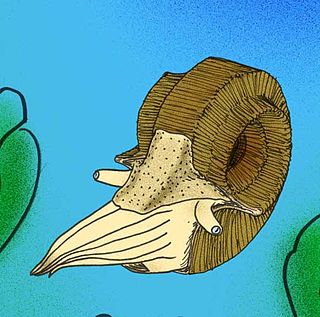
Ammonoids are a group of extinct marine mollusc animals in the subclass Ammonoidea of the class Cephalopoda. These molluscs, commonly referred to as ammonites, are more closely related to living coleoids than they are to shelled nautiloids such as the living Nautilus species. The earliest ammonites appeared during the Devonian, and the last species either vanished in the Cretaceous–Paleogene extinction event, or shortly after, during the Danian epoch of the Paleocene.

The Early Triassic is the first of three epochs of the Triassic Period of the geologic timescale. It spans the time between 251.902 Ma and 247.2 Ma. Rocks from this epoch are collectively known as the Lower Triassic series, which is a unit in chronostratigraphy.

The Induan is the first age of the Early Triassic epoch in the geologic timescale, or the lowest stage of the Lower Triassic series in chronostratigraphy. It spans the time between 251.902 Ma and 251.2 Ma. The Induan is sometimes divided into the Griesbachian and the Dienerian subages or substages. The Induan is preceded by the Changhsingian and is followed by the Olenekian.

Xenodiscus is an extinct ammonoid cephalopod genus and one of the earliest ceratites, found in the Upper Permian of northern India and Timor. Xenodiscus is included in the family Xenodiscidae which is part of the ceratite superfamily Xenodiscaceae
Agathiceras is a subglobose goniatitid from the family Agathiceratidae, widespread and locally abundant in Lower Pennsylvanian to Middle Permian sediments, e.g. the Urals, Sicily, and Texas.
Aldanites is an extinct cephalopod genus belonging to the ammonoid order Goniatitida.

Araxoceras is an extinct genus of ceratitid ammonites that lived in the Late Permian marine environments of Iran, South China and Japan. The various species had distinctive, angular-cornered shells.
Aristoceratoides is an extinct ammonoid genus belonging to the goniatitid family Thalassoceratidae that lived during the Middle Permian. Named by Ruzhentsev, 1960, the type species is "Thalassoceras" varicosum Gemmellaro, 1887.
Arctoceras is a genus of ceratitid ammonoids from the Lower Triassic with a moderately narrow discoidal shell and ceratitic suture.
Yinoceras is a genus of middle Permian goniatitid ammonite, the type genus for the subfamily Yinoceratinae of the family Pseudohaloritidae.
Uraloceras is an ammonoid cephalopod genus belonging to the goniatitid family Paragastrioceratidae. The genus was named by Ruzhencev 1936 and is a jr. synonym of Pseudogastrioceras Spath 1930 according to Miller, Furnish and Schindeworlf, 1957. More recent classifications however list the two as distinct genera and put Uraloceras in the Paragastrioceratinae and Pseudogastrioceras in the Pseudogastrioceratinae.
Paratirolites is a genus of Early Triassic ceratites from Armenia and Iran with distinct ribs, prominent ventro-lateral tubercles, and a broadly arched venter. The suture is ceratitic with a large ventral saddle. Ceratites are ammonoid cephalopods that lived during the Late Permian and Triassic.
Dzhulfites is a genus of xenodiscoidean ceratitid ammonoids named by Shevyrev, 1965, for species found in the Upper Permian Julfa Formation of Azerbaijan and type genus for the Dzhulfitidae. The type species, Dzhulfites spinosus Shevyrev 1965 is based on Paratirolites spinosus. Dzhulfites is known from the Permian of Azerbaijan, Iran, and Thailand.
Sosioceras is an Upper Permian shouchangoceratin pseudohaloritid characterized by a subdiscoidal shell, about 2 cm in diameter, marked by growth lines, as with Neoaganides, and having a mature peristome with a double constriction near the periphery. The suture also closely resembles that of Neoaganides.
Shouchangoceras is a genus of goniatitid pseudohaloritid ammonoids and is the type genus for the pseudohaloritid subfamily Shouchangocerinae. The genus is characterized by a compressed shell as much as 5 cm in diameter, with a strongly constricted mature peristome that has shallow dorsolateral sinus, a moderately deep rounded ventral sinus, but without conspicuous lappets, and ornamented by moderately strong transverse ribs and numerous stronger longitudinal lirae, producing a weakly reticulate pattern. Lobes are attenuate. The siphuncle is within the dorsal septal flecture.
Cibolites is a genus of ammonoid in the family Paraceltitidae of the cephalopod order Ceratitida which lived during the Late Permian. The genus was first found the Texas and Mexico. The shell is similar to that of Xenodiscites but smooth and with goniatitic sutures.
Kingoceras is a genus of ammonoids in the order Ceratitida and family Paraceltitidae which lived during the Late Permian from about 265 to about 254 million years ago. The shell is thinly lenticular, sutures are goniatitic and have only eight fully distinct lobes.
Nielsenoceras is monotypic Paraceltitid genus of ammonoid from the Middle Permian, Capitanian, that is known from sediments in west Texas. The genus is distinguished by exceptionally broad prongs of the ventral lobe and by the presence of a shallow groove on the outer flanks.
Liostrea is a genus of extinct oysters, marine bivalve mollusks in the family Gryphaeidae.
Peritrochia is an extinct genus of ammonite belonging to the order Goniatitida and family Vidrioceratidae. Specimens have been recovered from Permian beds in North America and East Timor.




